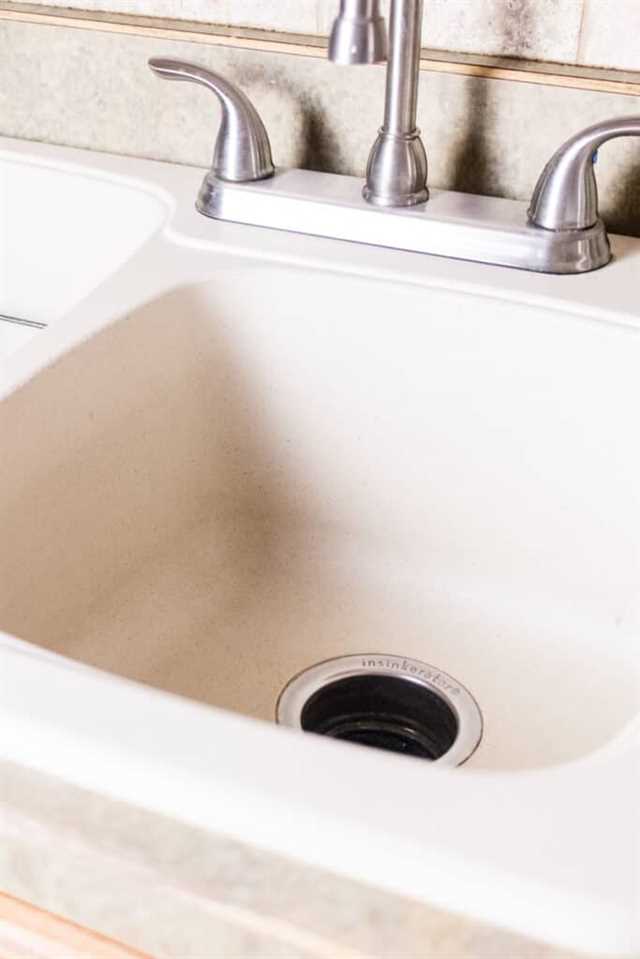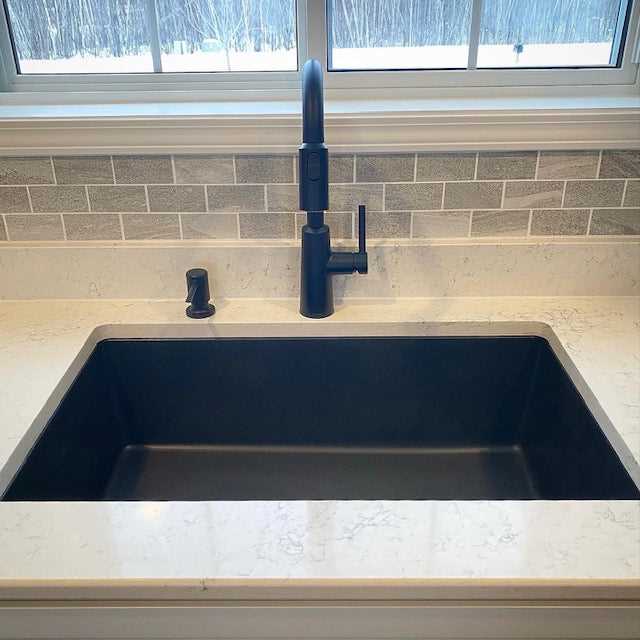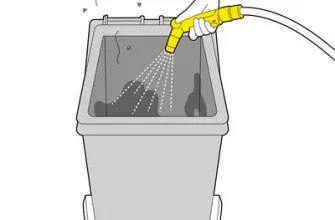
Composite sinks have become increasingly popular in modern kitchens due to their attractive, durable, and low-maintenance nature. However, like any other surface in your home, these sinks require regular cleaning to keep them in pristine condition. In this article, we will provide you with a step-by-step guide on how to effectively clean your composite sink and maintain its shine and functionality for years to come.
Before diving into the cleaning process, it’s important to note that composite sinks should never be cleaned with abrasive materials such as steel wool or harsh chemical cleaners. These can cause damage and leave permanent scratches on the surface. Instead, we recommend using gentle and non-abrasive cleaning methods that are safe for composite materials.
To start, gather the necessary cleaning supplies. You will need a soft sponge or cloth, warm water, a mild dish soap, and a non-abrasive cleanser specifically formulated for composite sinks. Avoid using bleach or any cleanser that contains bleach, as they can discolor or degrade the sink.
Begin by wiping down the sink with a damp cloth or sponge to remove any loose dirt or debris. Then, create a cleaning solution by mixing warm water with a small amount of dish soap. Dip your sponge or cloth into the soapy water and gently scrub the entire surface of the sink in circular motions. Pay extra attention to any areas with stains or stubborn dirt.
If you notice any limescale or hard water stains, you can create a paste using a mixture of warm water and baking soda. Apply the paste to the affected areas and let it sit for a few minutes to break down the mineral deposits. Then, scrub the area gently with a sponge or cloth to remove the stains.
For tougher stains or an ongoing deep clean, you can use a composite sink cleaner specifically designed for these types of sinks. Follow the manufacturer’s instructions and apply the cleanser to the sink, allowing it to sit for the recommended amount of time. Then, scrub the surface gently with a sponge or cloth to remove any dirt or stains.
Once you have finished cleaning the sink, rinse it thoroughly with warm water to remove any residue. Dry the sink with a clean cloth or towel to prevent water spots and ensure a streak-free finish. If you prefer, you can also use a mix of equal parts water and white vinegar as a natural alternative to a commercial sink cleaner.
It’s worth noting that composite sinks can scratch more easily than other materials like stainless steel, so be mindful of what you place in the sink and avoid dragging heavy pots or pans across the surface. Additionally, be careful with hot objects, as composite sinks are not heat-resistant and can be damaged if exposed to excessive heat.
In summary, cleaning a composite sink requires gentle and non-abrasive methods to maintain its appearance and functionality. By following the step-by-step guide outlined here and using the recommended cleaning products, you can keep your sink looking as good as new for years to come.
- What Is a Composite Sink
- How to Clean a Composite Sink
- Step 1: Remove debris
- Step 2: Choose the right cleaner
- Step 3: Clean the sink
- Step 4: Rinse and dry
- Step 5: Prevent future stains
- What to Use to Clean a Black Composite Sink
- Things to Avoid When Cleaning Composite Sinks
- Top Tips for a Cleaner Sink
- 1. Regular Cleaning
- 2. Know Your Sink Material
- 3. Avoid Harsh Cleaners
- 4. Use Gentle Tools
- 5. Rinse Thoroughly
- 6. Pay Attention to Extra Dirty Areas
- 7. Dealing with Stains
- 8. Preventing Scratches
- 9. Finish with a Shine
- 10. Prevention is Key
- Video:
- How to Clean a Granite Composite Sink
What Is a Composite Sink
A composite sink is a type of sink that is made from a combination of materials. It is usually composed of a mixture of quartz or granite particles and a resin binder. This mixture gives the sink a durable and attractive appearance. Composite sinks are popular in homes because they are available in a variety of sizes and colors, allowing homeowners to select the perfect sink for their kitchen or bathroom.
Composite sinks are easy to clean and maintain, making them a popular choice for many homeowners. However, it is still necessary to clean them regularly to keep them looking their best. In this guide, we will walk you through the step-by-step process of cleaning a composite sink to ensure that it stays in top condition for years to come.
How to Clean a Composite Sink
Composite sinks are a popular choice for many homeowners due to their durability and attractive design. However, like any other sink, they require regular cleaning to keep them looking their best. Here is a step-by-step guide on how to clean a composite sink:
Step 1: Remove debris
- Start by removing any debris or food particles from the sink. You can use a soft cloth or a dish brush to gently wipe away loose dirt.
- If there are any stains or stubborn dirt around the drain, use a soft cloth or a toothbrush to scrub the area.
Step 2: Choose the right cleaner
- It’s important to use a cleaner that is specifically designed for composite sinks. Avoid abrasive cleaners or those that contain bleach, as they can damage the sink’s material.
- A mixture of warm water and a mild dish soap is usually sufficient for regular cleaning. You can also use a paste made of baking soda and water for more stubborn stains.
Step 3: Clean the sink
- Using a soft cloth or sponge, apply the cleaner to the surface of the sink and scrub gently in circular motions. This will help to remove any dirt and stains.
- Pay special attention to areas that are prone to buildup, such as around the faucet and drain.
- If you have a composite sink with a darker color, you can add a few drops of lemon or feldspar liquid cleaner to the mixture to help maintain its shine.
Step 4: Rinse and dry
- After cleaning, rinse the sink thoroughly with warm water to remove any leftover cleaner.
- Wipe the sink dry with a clean, lint-free cloth to prevent water spots and keep the sink looking its best.
Step 5: Prevent future stains
- To keep your composite sink looking clean and fresh, it’s important to take some preventive measures. Avoid placing hot pans directly on the sink, as this can cause discoloration.
- Also, make sure to clean up any spills or stains as quickly as possible to prevent them from setting in.
- Regularly scrubbing the sink with a mixture of baking soda and water can help remove any soap residue and keep the sink looking new.
- Finally, avoid using harsh chemicals or abrasive sponges that can scratch or weaken the surface of the sink.
By following these steps and maintaining regular cleaning habits, you can keep your composite sink looking beautiful for years to come!
What to Use to Clean a Black Composite Sink
When it comes to cleaning your black composite sink, it’s important to use the right cleaner to ensure that you don’t damage the sink’s appearance. Black composite sinks require special care and attention to keep them looking their best.
The first step is to choose a cleaner specifically designed for composite sinks. These cleaners are formulated to quickly and effectively remove dirt, grime, and stains without causing any damage to the sink’s surface. Look for a cleaner that is specifically labeled for use on black composite sinks.
If you prefer to use a homemade cleaner, you can make a paste by mixing a small amount of dish soap with warm water. This gentle mixture is effective at removing dirt and stains without causing any damage to the sink. Apply the paste to a soft cloth or sponge and gently scrub the sink in a circular motion. Rinse thoroughly with warm water to remove any residue.
In addition to dish soap, you can also use baking soda or vinegar to clean your black composite sink. Baking soda is a mild abrasive that can help remove tough stains and limescale buildup. Mix a small amount of baking soda with water to create a paste, then apply it to the sink and scrub gently. Rinse thoroughly with warm water.
Vinegar is another effective cleaner for black composite sinks. It can help remove tough stains, bacteria, and odors. Simply pour vinegar over the sink and let it sit for a few minutes. Then, scrub the sink gently with a soft cloth or sponge. Rinse thoroughly with warm water.
If you have tough stains or limescale buildup that regular cleaners can’t remove, you can use a commercial cleaner specifically designed for composite sinks. These cleaners often contain stronger ingredients and are formulated to tackle the toughest stains. Follow the instructions on the cleaner carefully and make sure to rinse the sink thoroughly after use.
When cleaning your black composite sink, it’s important to avoid using harsh chemicals, abrasive sponges, or scouring pads, as they can scratch or damage the sink’s surface. Instead, opt for gentle cleaning methods and tools.
After cleaning, make sure to dry your black composite sink thoroughly to prevent water spots or mineral deposits from forming. Use a soft cloth or paper towel to wipe down the sink, paying extra attention to any areas that may be prone to water pooling.
If you notice any minor scratches or imperfections on your black composite sink, you can use a mild abrasive cleaner, like baking soda, to buff them out. Gently scrub the affected area in a circular motion, then rinse and dry the sink. This can help restore the sink’s appearance and minimize any visible damage.
In conclusion, cleaning a black composite sink requires using the right cleaner and taking care to avoid harsh chemicals or abrasive tools. Whether you decide to use a commercial cleaner or make your own homemade cleaner, follow the instructions and rinse the sink thoroughly afterward. With the right care, your black composite sink will stay looking its best for years to come.
Things to Avoid When Cleaning Composite Sinks

Composite sinks are a popular choice for many homeowners due to their durability and attractive designs. However, when it comes to cleaning these sinks, there are certain things you should avoid to prevent damage to the material and maintain their long-term beauty.
- Avoid using abrasive cleaners: When cleaning composite sinks, it’s important to steer clear of abrasive cleaners or scrubbing pads that can scratch or dull the surface. Stick with gentle cleaning solutions and soft cleaning tools.
- Avoid using bleach or bleach-based cleaners: While bleach may seem like a powerful cleaning agent, it can actually discolor or damage the composite resin in the sink. Opt for milder cleaning solutions instead.
- Avoid using excessive heat: Avoid placing hot pans or pots directly on the surface of the composite sink. Extreme heat can cause the material to warp or melt, compromising its integrity.
- Avoid leaving mineral build-up: Hard water can leave mineral deposits on your composite sink, making it look dull and unattractive. Regularly clean and dry the sink to prevent mineral build-up.
- Avoid using nylon-bristled brushes: While nylon-bristled brushes may seem like a safe option, they can actually leave scratches on the surface of the sink. Opt for soft cleaning tools to protect the sink’s finish.
- Avoid leaving food or stains for too long: It’s important to wipe up any food spills or stains on the sink’s surface as soon as possible. Leaving them for too long can lead to difficult-to-remove stains or discoloration.
By avoiding these common mistakes, you can ensure that your composite sink remains clean, attractive, and in good condition for many years to come.
Top Tips for a Cleaner Sink
Keeping your sink clean and free of stains is essential for maintaining a hygienic and visually appealing kitchen. Here are some top tips to help you achieve a cleaner sink:
1. Regular Cleaning

It is important to clean your sink regularly to prevent dirt and stains from building up. Use a mild cleanser and a sponge or cloth to remove any grime or food particles.
2. Know Your Sink Material
Different sink materials require different cleaning methods. Whether you have a stainless steel, granite, or composite sink, make sure to familiarize yourself with the manufacturer’s recommended cleaning instructions.
3. Avoid Harsh Cleaners
Avoid using abrasive cleaners that can damage the surface of your sink. Stick to mild cleansers or natural cleaning agents like vinegar and baking soda.
4. Use Gentle Tools
When scrubbing your sink, use a nylon-bristled brush or sponge to avoid scratching the surface. Avoid using steel wool or abrasive brushes.
5. Rinse Thoroughly
After cleaning, make sure to rinse your sink thoroughly with water to remove any residue from the cleanser. Leaving cleanser residue can cause dullness or discoloration over time.
6. Pay Attention to Extra Dirty Areas
Areas around the drain or corners of the sink may require extra attention. Use a toothbrush or a small brush to clean hard-to-reach areas.
7. Dealing with Stains
If you have stubborn stains on your sink, make a paste using a mixture of baking soda and water. Apply the paste to the stained area and scrub gently with a soft cloth or sponge.
8. Preventing Scratches
To prevent scratches, avoid placing sharp or abrasive objects directly on the sink surface. Use a cutting board or trivet to protect the sink.
9. Finish with a Shine
For extra shine, wipe your sink with a clean, lint-free cloth or towel. You can also use a small amount of mineral oil to add a glossy finish to your sink.
10. Prevention is Key
To keep your sink looking great, make it a habit to quickly wipe away spills and clean up any messes as soon as they happen. This will prevent stains and make regular cleaning easier.
Follow these tips, and your sink will not only remain functional but also show off its true beauty!








